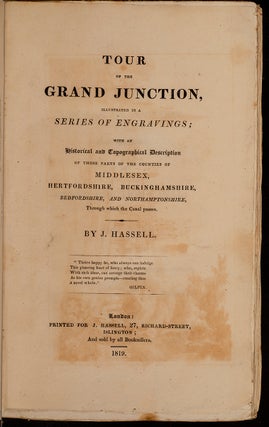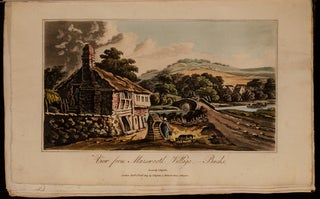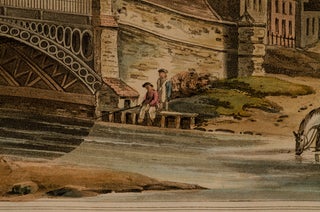Tour of the Grand Junction
London: Printed for J. Hassell…, 1819. Item #00637
A Rare Large-Paper Copy
In the Original Drab Boards
Twenty-Four Hand-Colored Aquatint Plates
HASSELL, J[ohn]. Tour of the Grand Junction, Illustrated in a Series of Engravings; with an Historical and Topographical Description of Those Parts of the Counties of Middlesex, Hertfordshire, Buckinghamshire, Bedfordshire, and Northamptonshire, Through Which the Canal Passes. London: Printed for J. Hassell…Islington; And sold by all Booksellers, 1819.
First edition. Large paper copy. Octavo (8 7/8 x 5 1/2 inches; 225 x 138 mm.). viii, 147, [1, blank], [3, index], [1, “Directions for Placing the Cuts”] pp. With twenty-four hand-colored aquatint plates by J. Hassell. Dates not visible on the plate watermarks.
Uncut, in the original drab boards, expertly rebacked to style at an early date. Front cover with the original printed paper label. Bookplate of John H. Baker on front pastedown. Some minor offsetting from a few plates to the facing text otherwise a very fine and large uncut copy.
The Grand Junction Canal was designed to facilitate water transport from Oxford Canal to London, in place of the uncertain Thames River. The canal was opened in 1800 and pretty well completed in 1805, and its 93 miles of waterway, with two long tunnels, did greatly improve cargo shipping. It is now, like all the canals of England, used almost entirely for pleasure cruising.
“The Tour of the Grand Junction, an octavo volume with twenty-four aquatints drawn, and probably engraved, by Hassell, appeared in 1819… Canals at this period were the great highways of commerce, and the shares of the Grand Junction, opened as far as Uxbridge in 1801, had risen in 1818 from their original price of £100 to £250. Shortly before the publication of this book it had been the vogue for London Society to visit Uxbridge on barges drawn by horses gaily decked with ribbons” (Martin Hardie).
In 1877, Charles Kingsley suggested that urbanites should go into the countryside as a desirable escape from the city, but in 1819, the artist John Hassell (1767-1825) had already suggested in his Tour of the Grand Junction that his readers could observe some excellent scenery when they escaped from ‘the populous town’ and the ‘busy hum of men’, and traveled through the countryside by boat. Hassell, who published fifteen engraving of the canal, explains:
"The Grand Junction or Braunston Canal is so peculiarly distinguished, that truly it may be said, from its junction with the Thames to its termination at Braunston, to be an almost perpetual succession of variegated beauty, shaping its devious course through some of the richest vallies of Middlesex, Hertfordshire, Buckinghamshire and Northamptonshire, accompanied by a redundance of the most luxuriant scenery, and lined on its sides with a succession of rising eminences. It gradually ascends from the bed of the Thames by the means of its locks, the entire way to Marsworth, a distance of nearly forty miles, by the banks of the canal" (page 4).
John Hassell (c. 1767 – 1825) was an English watercolor landscape painter, engraver, illustrator, writer, publisher and drawing-master. He drew many views of local scenery, which he engraved himself in aquatint, most of them colored. They were published in various topographical works. He also had a large practice as a drawing-master, and published some books on water-color painting and drawing.
Abbey, Scenery, 30; Martin Hardie, pp. 140-141; Tooley 252.
Price: $3,500.00

 I have been in the rare and antiquarian book business for over forty years; my family has been in the rare books business since 1876. Rare books are in my blood.
I have been in the rare and antiquarian book business for over forty years; my family has been in the rare books business since 1876. Rare books are in my blood.








